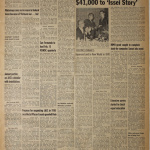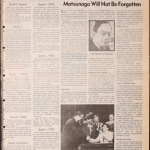Home Again (book)
| Title | Home Again |
|---|---|
| Author | James Edmiston |
| Original Publisher | Doubleday & Company |
| Original Publication Date | 1955 |
| Pages | 316 |
| WorldCat Link | http://www.worldcat.org/title/home-again/oclc/1938107 |
A 1955 novel authored by a former War Relocation Authority (WRA) official that tells the epic story of one Japanese American family from California, covering their prewar travails, their wartime incarceration, and their return to California after the war. The book was heavily promoted particularly within the Japanese American community and widely reviewed.
Author James Edmiston was the head of the WRA's San José office, where he assisted many Japanese Americans in their return to the area after their exile. The characters and events in the book were based on his observations from that time; as he wrote in the book's foreword, "It should be pointed out that the fiction form this story has taken in no way alters the authenticity of the material. The characters are real; the incidents all occurred."
The story focuses on the Mio family, beginning with the arrival of a picture bride for one of the Mio brothers in 1909 and following their rise over anti-Japanese discrimination to become successful chrysanthemum growers in California's Santa Clara Valley. But like all West Coast Japanese Americans, the family is forcibly removed and incarcerated, first in the Santa Anita Assembly Center , then in the American concentration camp at Heart Mountain , Wyoming. Family patriarch Toshimichimaru and wife Tani are joined there by dissident son (and eventual draft resister) Kazuo; daughter and family pillar Midori; another daughter Emiko, who becomes a physician; Hiro, who volunteers for the 442nd ; and younger children Sumiko and Michio. As the war winds down, the family returns to San José, aided by WRA staffer Sam Morgan (clearly based on the author himself), overcoming the vandalism and terroristic threats many returnees faced. In the midst of this, Midori finds herself in an interracial romance with the son of a wealthy local rancher and longtime anti-Japanese activist.
The book was widely and sympathetically reviewed, though the reviews were mixed in assessing the book's literary merit. In the New York Times , Gladwin Hill wrote that "the author knows his subject intimately" and "has amassed enough fact, color and drama for an epic trilogy." However, Hill added, "But the wealth of his material has defeated him. Overwhelmed by the task of selection and organization, he has resorted to chronological recitation.... the creative magic that shapes the raw stuff of life into fiction is simply absent." Similarly, Alden Whitman in The Saturday Review wrote that the author "knows his Japanese-Americans well, and he writes of them with sensitivity and understanding," but laments that he "presents his vast mass of raw documentation in the form of fiction, a device that blunts and diffuses the book's emotional force." The Christian Century reviewer noted "a scenario-simplicity about the style which limits the depths that could have been sounded in more leisurely passage," while the reviewer in The Nation stated that while Edmiston "has written out of knowledge, and with love and anger," that "his knowledge, love, and anger are greater than his craftsmanship." The San Francisco Chronicle book review editor singled it out as a book "Worth Keeping In Mind" while Francis Witherspoon of the New York Herald Tribune wrote that "Doubtless not all the blows suffered by the Mios in the years of exile fell upon a single family. But so convincing is James Edmiston that we believe they actually did." [1]
The reception by the Japanese American community was generally positive given the sympathetic portrayal of the Mios by a wartime "friend." The book is approving of the accommodationist/assimilationist bent best represented by the Japanese American Citizens League (JACL) and includes a quote from JACL leader Mike Masaoka opposite the title page. (The lone contemporary critique of the assimilationist leaning of the book came from the perceptive unnamed reviewer from The Nation , who criticized the approval of Japanese Americans discarding their culture as a way to prove their American-ness. Quoting the last lines of the book—"And at last Midori is free. The nihonjin is gone. This is total victory, incomparable completeness"—the reviewer asks "Total or totalitarian? Midori Mio, in suppressing the nihonjin, gains nothing and loses much. Too much.") It was extensively covered in the JACL's Pacific Citizen (PC) newspaper, and the national JACL office sold the book to members at a discount. No fewer than eight PC columnists note the book (and/or the planned movie) in their columns, many mentioning it multiple times. Columnists Larry Tajiri and Tats Kushida also breathlessly followed the efforts to make the book into a movie, with producer Sam Jaffe and writer/director Michael Blackfort visiting with JACL officials, producing a completed script, and putting out a casting call via the PC. But after early 1956, there is no further mention of the movie project. [2] Edmiston did go on to write scripts for a variety of 1950s TV shows before his premature passing at age 47 in 1959.
With the many more recent fictional accounts and memoirs—many by Japanese Americans themselves— Home Again has faded into obscurity.
Find in the Digital Library of Japanese American Incarceration
This item has been made freely available in the Digital Library of Japanese American Incarceration , a collaborative project with Internet Archive .
Might also like:
When the Emperor Was Divine
by Julie Otsuka;
[The Harvest of Hate
https://resourceguide.densho.org/The%20Harvest%20of%20Hate%20(book)/
]
by Georgia Day Robertson;
The Moved-Outers
" by Florence Crannell Means;
For More Information
Edmiston, James. Home Again . Garden City, NY: Doubleday & Company, 1955. 316 pages.
Reviews
"Good News." Christian Century , March 9, 1955, 304–05. ["His energetic participation in the whole effort to save a tragically abused people (without worrying about saving ‘The People’s face) prepared him to tell the story with a passion and compassion that lift it out of the ordinary."]
Hill, Gladwin. "Tragic Uprooting." New York Times , January 30, 1955, section VII, 23. ["Properly organized, this book could have been made into a truly memorable novel. But the creative magic that shapes the raw stuff of life into fiction is simply absent."]
"Total or Totalitarian?" The Nation , September 3, 1955, 208. ["Mr Edmiston has written out of knowledge, and with love and anger. Evidently he chose the novel form in order to reach a larger audience than has been won for several excellent non-fiction works. Unfortunately his knowledge, love, and anger are greater than his craftsmanship."]
Whitman, Alden. " The Nisei in Wartime. " The Saturday Review , April 9, 1955, p. 22. ["Mr. Edmiston presents his vast mass of raw documentation in the form of fiction, a device that blunts and diffuses the book’s total emotional force."]
Witherspoon, Francis, New York Tribune Herald , January 23, 1955, 3. ["Doubtless not all the blows suffered by the Mios in the years of exile fell upon a single family. But so convincing is James Edmiston that we believe they actually did."]
Footnotes
- ↑ Gladwin Hill, "Tragic Uprooting," New York Times , January 30, 1955, section VII, 23; Alden Whitman, "The Nisei in Wartime," The Saturday Review , April 9, 1955, 22, accessed online on February 15, 2013 at http://www.unz.org/Pub/SaturdayRev-1955apr09-00022a03 ; "Good News," The Christian Century , March 9, 1955, 304–05; "Total or Totalitarian?," The Nation , September 3, 1955, 208; San Francisco Chronicle This World , January 23, 1955, 20; Francis Witherspoon, New York Herald Tribune , January 23, 1955, 3, cited in The Book Review Digest 1955 , edited by Mertice M. James and Dorothy Brown (New York: The H.W. Wilson Company, 1956), 272.
- ↑ The eight: Larry Tajiri (five times), Tats Kushida (5), Bill Hosokawa (2), Masao Satow (2), Mike Masaoka; Henry Mori, Smokey Sakurada, and Budd Fukei.
Last updated April 8, 2024, 2:43 a.m..


